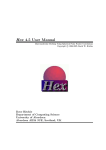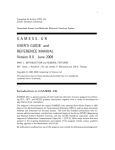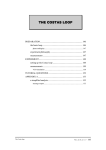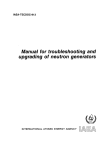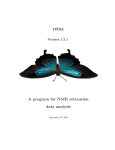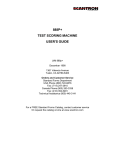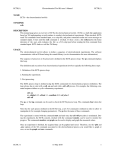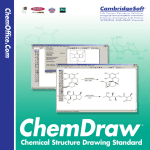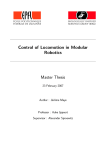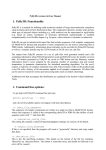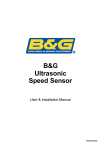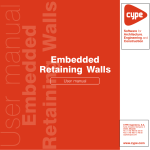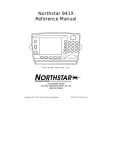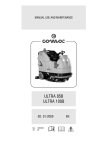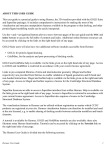Download Version 1.1 User Manual - Laboratory of Biomolecular Modeling
Transcript
Version 1.1 User Manual Contents 0. Introduction ........................................................................................................................2 1. Theory ................................................................................................................................3 1.1. Docking and Scoring ...................................................................................................3 1.2. Molecular Hydrophobicity Potential (MHP) ..............................................................4 1.3. Stacking and Aromatic Interactions ............................................................................6 1.4. Hydrogen Bonds .........................................................................................................7 1.5. RMSD and TcIFP........................................................................................................8 2. Usage ................................................................................................................................10 2.1. Uploading Molecules ................................................................................................11 2.2. MHP Parameters .......................................................................................................13 2.3. 2D-Hydrophobicity Maps .........................................................................................17 2.4. Scoring the Results of Docking ................................................................................18 2.5. Visualization of Hydrophobic/Hydrophilic Properties in Jmol ................................20 2.6. Saving Data to View MHP in a Molecular Visualization Application .....................21 2.7. Format of Output Files for Visualizing MHP ...........................................................23 2.8. Processing WARNING and ERROR messages ........................................................25 3. Getting Help, Feedback and References ..........................................................................27 4. Cited Literature ................................................................................................................28 1 0. Introduction PLATINUM (Protein-Ligand ATtractions Investigation NUMerically) web-service is designed for analysis of hydrophobic/hydrophobic jrganization of biomolecular complexes. PLATINUM numerically estimates hydrogen bonds, stacking and hydrophobic intearactions in receptor-ligand complexes. This feature can be used to filter docking poses generated by jther software. PLATINUM generates 2D hydrophobicity maps for certain molecular systems - lipid bilayers and α-helical peptides. This feature (included in version 1.1) facilitates analysis of hydrophobic/hydrophilic interactions in complex biomolecular systems. 2 1. Theory 1.1. Docking and Scoring PLATINUM does not perform ligand docking or any geometry optimization – it only uses given 3D coordinates of biological molecules to calculate and visualize their hydrophobic/hydrophilic properties. PLATINUM also calculates hydrophobic/hydrophilic match between two interacting molecules. These are referred to as receptor and ligand. However all this is relative – user can supply a lipid bilayer as receptor and a peptide as the ligand or even vice versa. Hydrophobic/hydrophilic match can be used to filter the results of molecular docking. This can be particularly useful in certain cases (e.g. docking of nucleotides; Pyrkov et al., 2007) where hydrophobic interactions play the crucial role in molecular recognition and therefore deserve more precise analysis. To facilitate the analysis of docking poses multiple ligands can be uploaded with the same structure of receptor. 3 1.2. Molecular Hydrophobicity Potential (MHP) Hyrophobic effect plays crucial role in biomolecular recognition and sustaining 3D structure of complex molecular systems in a living cell (e.g. lipid bilayers, lipid-protein complexes). The force driving apolar substancies to avoid contacts with polar solvent (water) results in effective hydrophobic (lipophilic) interaction and has very complex physical nature. To describe this effect in molecular biology empirical methods are used, which are mostly based on experimental data on partitioning of organic compounds between polar and apolar environments (see review for details: Efremov et al., 2007). A popular approach is to use the formalism of Molecular Hydrophobic Potential (MHP) a.k.a. Molecular Lipophilic Potential (MLP). Each atom is assigned a hydrophobic (positive) or hydrophilic (negative) constant derived from experimental data. PLATINUM uses parameterization on octanol/water partition data from two sources: Ghose et al., 1998 and Viswanadhan et al., 1989. Then the hydrophobic properties can be calculated on molecular surfaces or on a 3D grid (Fig. 1.1). Exponential decay is most popular (Fauchere et al., 1988; Gaillard et al., 1994), however hyperbolic (Audry et al., 1986) or Fermi-like cut-off (Heiden et al., 1993) functions are also applied in some studies and are implemented in PLATINUM. Figure 1.1. The concept of Molecular Hydrophobicity Potential (MHP). Let us consider for instance Russian vodka. Each atom in a molecule (ethanol or water) is assigned a tabulated empirical hydrophobic or hydrophilic (positive or negative, respectively) constant based on molecular topology. Then hydrophobic/hydrophilic properties of a molecule can be calculated on its surface and compared to the properties of neighboring molecules to estimate the hydrophobic effect. MHP at point j is a sum of atomic MHP constants fi decaying with the distance rij. To estimate the hydrophobic/hydrophilic complementarity of a ligand to the receptor binding site PLATINUM calculates hydrophobic/hydrophilic properties of both the ligand and its environment on the ligand molecular surface (the interface). While for ligand it is rather straightforward to do, some issues arise when its environment is considered. Metal ions present in the active site of many enzymes lack parameterization for MHP. By default PLATINUM assignes them a constant of -1.37 corresponding to experimental logP of a water molecule. Solvent (except reacting water molecules) is omitted in the docking process leaving an empty space around the ligand. PLATINUM surrounds the ligand by a rectangular grid of “water hydrophilic charges” (Fig. 1.2). 4 Figure 1.2. Grid simulating hydrophilic properties of water which is implemented in PLATINUM. Grid nodes fill the empty space around ligand (dark molecule) bound in the active site of receptor (light molecule, represented by ribbon). The parametes of the grad are: grid step = 2 Å; grid node hydrophilic constant = -0.38. By complementarity of hydrophobic and hydrophilic properties between receptor and ligands we mean that hydrophobic–hydrophobic and hydrophilic–hydrophilic receptor-ligand contacts are favorable or complementary and hydrophobic–hydrophilic contacts are anticomplementary (unfavorable). PLATINUM calculates hydrophobic/hydrophilic complementarity based on surface area of favorable and unfavorable contacts which are attributed to one of the six types (Fig. 1.3): LL LH LH' HL HH HH' – Lipophilic ligand, Lipophilic receptor; – Lipophilic ligand, Hydrophilic receptor; – Lipophilic ligand, Hydrophilic solvent (water); – Hydrophilic ligand, Lipophilic receptor; – Hydrophilic ligand, Hydrophilic receptor; – Hydrophilic ligand, Hydrophilic solvent (water). Figure 1.3. Types of contacts between ligand and its environment on ligand molecular surface. Each dot type corresponds to different combination of ligand and environmental MHP (i.e. hydrophobic/hydrophilic properties). Character “L” means lipophilic (brown, oil-colored) and “H” – hydrophilic (blue, water-colored). Apostrophe symbol designates exposed ligand surface which is in contact with hydrophilic solvent. Hereinafter, each of these codes will be used to designate the corresponding surface area (for example SLL is the area of ligand molecular surface corresponding to dots of type LL). To rank the uploaded list of complexes, the user may choose between different criteria (See section 3.3 “Scoring the results of docking”). 5 1.3. Stacking and Aromatic Interactions Aromatic fragments often form stacking and “T-shaped” contacts, which to our view are not always paid due attention in many scoring functions. The most popular example is DNA where parallel stacking between nitrogen bases contributes much to the stability of a macromolecule. While this type of interactions is not as widespread as e.g. h-bonds or hydrophobic contacts, the thing may be quite different in case of some specific types of ligands. Thus, we have shown that stacking plays important role in recognition of ATP (Adenosine triphosphate) by proteins (Pyrkov et al., 2007). Figure 1.4. Scheme of geometrical parameters used to describe a stacking contact between two aromatic rings. Displacement (d) and height (h) are calculated for the center of one aromctic ring relative to another ring’s plane. Angle α is calculated as the angle between the normal vectors of both rings. Currently, PLATINUM implements a simple method to detect a stacking contact between a ligand and a receptor based on geometrical parameters. Stacking in PLATINUM is estimated by the following formulas: where d and h are, respectively, displacement and height of the center of one aromatic ring relative to each other, and α is the angle between their planes (Fig. 1.4); cos ; sin 1.0; / ; / ; 0.0; 1.0; 0.0; where the particular form of Sα(α) defines whether we observe parallel (cos2α ≥ 0.5) or “T-shaped” edge-toface (sin2α > 0.5) stacking; where h1 = 4.0 Å and h0 = 5.0 Å for parallel stacking and h1 = 5.0 Å and h0 = 6.0 Å for edge-to-face stacking; where d1 = 2.0 Å and d0 = 3.0 Å for any type of stacking arrangement. The parameters of stacking were derived from the statistical analysis of contacts of nucleobases with aromatic amino acids in proteins (Pyrkov et al., 2007). For each ring of a conjugated aromatic cycle stacking is calculated separately and then summed (for e.g. naphtalene the value can be greater than 1.0). Flat guanidinium groups (which can be found in Arg side chain) are treated in the same way as aromatic rings. 6 1.4. Hydrogen Bonds Hydrogen bond are also identified simply by geometrical criteria according to the following formulas: where rAD is the distance between the hydrogen donor and acceptor and αADH is the angle betwee acceptor, donor, and the hydrogen atom (Fig. 1.5); 1.0; / where r1 = 3.2 Å and r0 = 3.4 Å; ; 0.0; 1.0; / where α1 = 0° and α0 = 20° when donor is nitrogen and α1 = 20° and α0 = 40° when donor is oxygen (in this case PLATINUM also rotates the hydrogen atom seeking for best geometry); αideal = 0°. ; 0.0; | | Figure 1.5. Scheme of geometrical parameters used to describe a hydrogen bond. 7 1.5. RMSD and TcIFP Root-mean-square deviation (RMSD) and Tanimoto coefficient of interaction fingerprints (TcIFP) are the measures of similarity between two distinct docking poses. Using these criteria, all docking solutions can be clustered into groups to reduce redundancy or compared to the correct crystallographic structure when testing the performance of a docking algorithm. RMSD is the most common way to compare docking poses. RMSD between poses a and b is calculated over 3D-coordinates of all N heavy atoms of ligand by the following equation: ∑ For two completely similar positions of ligand in 3D-space RMSD = 0. Usually, in docking applications RMSD 2 Å is considered acceptable, i.e. if docking yields ligand poses within this cutoff of RMSD from crystallographic (or NMR) structure for most of the reference receptor-ligand complexes it is likely to produce reliable predictions for others. IFP represents a more complex notion and has not yet achieved wide use. The basic idea is that RMSD does not always provide complete information about the similarity of orientation of a ligand in the binding site. Thus, in some cases even low RMSD may correspond to distinctly different intermolecular contact pattern and vice versa. One way to treat this problem may be using some quantitative measure of similarity of contacts with receptor, such as hydrogen bonds, salt-bridges, etc. And IFP provides such measure. Figure 1.6. An example of IFP bit string. Inhibitor staurosporin is shown in CyclinDependent Kinase 2 active site (PDB code 1AQ1). Interactions of selected residues are shown as they are encoded into an IFP bit string. 8 Introduced recently (Deng et al., 2004), IFP represents a conversion of 3D pattern of contacts between ligand and receptor into 1D bit string. Here, a set of bits, corresponding to different intermolecular contacts is assigned to each receptor residue in the vicinity of the ligandbinding site (Fig. 1.6; in PLATINUM these bits are different from those in the original implementation by Deng et al., 2004, see below). When a contact with a particular residue is observed, e.g. a hydrogen-bond is formed, the corresponding bit is raised. And two bit-strings coding two docking poses can be compared now indicating whether they are similar or not. To compare the strings A and B, coding two ligand poses a Tanimoto coefficient is used: | | | | Here A B is the number of raised bits common to both poses, and A B is the number of bits raised for either ligand A or B. Consequntly the value of TcIFP can vary between 0 (different poses) and 1 (identical poses). A weak point of the IFP comes from its definition: Criteria to judge whether a contact is formed or not, are not universal. Thus, although IFP was introduced only some years ago, a number of different approaches to treat the interaction bits has already been described in literature. This is because besides such contacts as hydrogen-bond with well-defined geometrical parameters, there exist stacking or hydrophobic contacts for which different criteria may be applied. For stacking this problem can be solved to some extent by data extraction from structural databases (Pyrkov et al., 2007, Meyer et al., 2003). Meanwhile for hydrophobic interaction this task is quite more challenging since the nature of forces driving this interaction is still poorly understood. So, in PLATINUM we used our own approach to describe ligand– receptor contacts. These contacts and the rules defining their formation are listed in Table 1.1 (However later these may undergo improvement and any remarks are welcome). Table 1.1. Interaction bits in IFP. Interaction bit rules h-bond 1) rDA < 3.4 Å; 2) <ADH < 40° (or in case of –OH group: <RDA = 105° ± 20°) h-bond (to protein main chain) salt-bridge Same + receptor is a protein molecule and its atom is named “O” or “N” in the structure file rNP < 6Å metal ligation bond rAM < 4Å stacking (including guanidinium group) 1) d < 3Å; 2) h < 5Å and cos2α > 0.1 (for parallel stacking); 2’) h < 6Å and sin2α > 0.1 (for T-shaped stacking) hydrophobic At least 2 recptor hydrophobic atoms are within 7Å to hydrophobic ligand atoms. 9 comments A – acceptor; D – donor; H – hydrogen; R – atom next to –OH group; N – atom with formal negative charge; P – atom with formal positive charge; M – metal ion; A – ligated atom, same as acceptor in h-bond d – displacement; h-height and α – angle between two plane fragments represented by their centers (see picture in Theory section) 2. Usage Briefly, the workflow of PLATINUM is the following: Step 1. Upload ligands and receptor in separate files (Section 2.1). Step 2. Set MHP parameters. Optionally mark here one of the ligands as the reference to compare all the others to this one by RMSD, e.g. ligand pose taken from the X-ray structure. Then launch PLATINUM calculation (Section 2.2). Step 3. Two panels appear on the results page. On the Receptor panel user can set parameters for generation of 2D hydrophobicity maps for certain types of molecules lipid bilayers and α-helical peptides (Section 2.3). On the Ligand(s) panel user can sort docking solutions by one of the interaction terms. Download data in a tab-separated text file (Section 2.4). Step 4. If desired, it is possible to view distribution of hydrophobic properties for selected “best” solutions either by downloading files with precalculated MHP data (click the floppy-disk icon ) or in Jmol applet on the PLATINUM web server (click the molecule icon ). (Sections 2.5 – 2.7). Important! The results of PLATINUM calculations are stored for 30 days and are accessible via the unique uid code. To get these results press the “Goto results page” caption in the upper right corner on the PLATINUM main page. A dialog appears where the uid code should be entered. This code is sent you by e-mail (if it was provided) or you shoud copy and save the URL when you see the results page for the first time. 10 2.1. Uploading Molecules PLATINUM supports input in five popular molecular file formats: pdb, mol2, sdf, gro (used in the GROMACS package for molecular dynamics (Berendsen et al., 1995)), and mae (used in molecular modeling package Maestro (Schrodinger LLC, 2007)). PLATINUM does not perform ligand docking or any geometry optimization – it only uses given 3D coordinates of biological molecules supplied by user. Any file can be uploaded as either receptor or ligand. Molecules in such files will be treated in different ways. All calculations (hydrophobic properties, interactions with receptor, etc.) are performed for ligands. Receptor is only an environment for ligands. If multiple ligands were uploaded one of them can be selected as the reference ligand – to calculate RMSD and TcIFP (see Theory) with other ligands. However 2D-hydrophobicity maps are generated for molecules (or molecular systems) uploaded as receptor. To upload files use the front panel (Fig 2.1). Here, the reference ligand should also be listed in the ligand section. Figure 2.1. The upload files menu. Here, the receptor and the ligand files can be uploaded to the PLATINUM server. In this example the first ligand file is extracted from the X-ray structure 1VFP (complex of Ca-ATPase with ATP analogue), the others are docking poses. At the next step, the file 1VFP_atp.pdb will be marked as the reference structure. All docking poses will be compared to it by the RMSD values. 11 Important issues. Remember that receptor and ligand molecules should be submitted in separate files! Parameterization of atomic hydrophobicity constants requires that all atoms are protonated! By default PLATINUM web server uses Adobe Flash Player 9 to upload files (version 10 does not work!). If Adobe Flash Player 9 is not installed on the computer one can use stadard upload file form (click “simple mode”), which however may be somewhat boring when many ligands are to be uploaded. Java applet is required to be installed for on-line visualization of molecular hydrophobic/hydrophilic properties. The size of the molecules is limited to 5 Mb which roughly corrsponds to a molecule of 40,000 atoms (in mol2 file) and is obviously suitable for most practical applications Any ligand file can contain more than one molecule, but this is not recommended. If docking poses are uploaded in a single file PLATINUM will split the file and rename all the poses adding numerical index. Reference ligand can be selected at the next step. You can mark any one of the entries as reference – not mandatory the first one. Only heavy atoms are used in calculation of RMSD and IFP. RMSD will be set to -1.0 and IFP to -1.0 if either reference ligand was not marked or PLATINUM did not manage to identify corresponding atoms in ligands (these are atoms with identical atom name and residue name and number). 12 2.2. MHP Parameters PLATINUM was mainly designed to facilitate analysis and visualization of hydrophobic/hydrophilic properties of biological molecules. Some software packages provide tools to calculate these properties using the same formalism of MHP. However, there is often required a tool providing more flexibility of calculation. PLATINUM provides a possibility to change some of these parameters (Fig. 2.2). Below is the list of these parameters with discussion of the effect they may exert on the final result. Figure 2.2. The MHP parameters tab. You can also provide your email address to receive URL for the results page on the PLATINUM server by mail. MHP table New (Ghose, 1998) Obsolete (Viswanadhan, 1989) The parameterization of atomic hydrophobic/hydrophilic constants used in PLATINUM implies a full-atom model – make sure that hydrogen atoms were added prior uploading files. Two variants of this parameterization exist: The former one (Viswanadhan et al., 1989) and the upgraded (Ghose et al., 1998). The resulting picture may differ for these two parameterizations: The major changes in the new table relate more realistic negative (hydrophilic) constants for some heteroatom types, particularly oxygen. Therefore, it is recommended to use the new version, although the previous one was also kept in the program (mainly for comparison purposes). For protein residues there will be little difference, however, for low molecular weight compounds the difference between these two parameterizations may be prominent. 13 Distance function exponential [exp(-r/2)] exponential [exp(-r)] hyperbolic Fermi-like Since MHP is an empirical approach, no “exact” distance-dependent decay function is known (like it is for electrostatic or van der Waals energy). Several different approaches have been described in literature. The most popular is the exponential function: where MHPj is the hydrophobicity potential at point j, N is the number of atoms, r is the distance between point j and atom i in Å, and α has the dimension of Å-1. Usually α = 1 Å-1 (Fauchere et al., 1988) or α = ½ Å-1 (Gaillard et al., 1994; default in PLATINUM) are used. Alternatively, a hyperbolic function was proposed by analogy with the electrostatic potential energy. It is calculated according to the following formula (Audry et al., 1986): 1 where α = 1 Å-1. The unit was added to r in the denominator to avoid infinite values in the vicinity of atom. Later, it was shown that this approach works well for small molecules, but for protein it results in overaveraging of MHP on the surface due to large contribution of inner atoms and therefore, a more rapidly decaying dependence is needed. Finally, one can use averaging of atomic hydrophobicity constants in the vicinity of point j with a cut-off function smoothed as a Fermi-like potential (Heiden et al., 1993): ∑ 1 ∑ 1 where α = 1 Å-1. Here, only atoms that are closer than 4 Å to the point j are effectively contributing to the MHPj. MHP offset [-1.5; +1.5] Empirical atomic hydrophobicity constants may need some correction to produce more realistic picture of distribution of molecular properties. We found that moderate shift to the more hydrophobic range improves the distribution of properties for low-molecular-weight compounds, particularly nucleosides and nucleotides (Fig. 2.3). Meanwhile, such moderate shift does not influence protein MHP greatly. So, it is recommended to use MHP offset of 0.03 logP units, which is added to each atomic hydrophobicity constant prior to any MHP calculations. User can change this value in the range [-1.5; +1.5], which covers the tabulated atomic constants. To return to initial parameters (as they appear in the parameterization table) the MHP offset should be set to zero. 14 MHPshift(ligand) [1.0; +1.0] MHPshift(receptor) [1.0; +1.0] These parameters are similar to the MHP offset but allow more flexible tuning of MHP values. While the “MHP offset” adds the same constant to both the ligand and the receptor atoms, “MHP shifts” provide separate change for these molecules. The difference is that “MHP shifts” are added not to atoms, but to MHP at surface points (or grid points). However the effect of “MHP offset” = 0.5 and “MHP shift” = 0.5 is almost the same. Both “MHP shift” values can be varied in the range [-1.0; +1.0]. Figure 2.3. Correction of tabulated atomic hydrophobicity/hydrophilicity constants may give more realistic picture. This is illustrated with ATP – a ligand representing a wide class of nucleobase-containing ligand compounds. Aromatic purine ring usually tends to form hydrophobic contacts with protein residues and indeed has less hydrophilic MHP values than the ribose and phosphate moieties. However, a moderate shift of atomic constants to the hydrophobic range provides a more clear picture (right in comparison with left) providing the basis for numerical assessment of hydrophobic complementarity. Also the same shift of atomic constants does not alter the overall picture for protein molecule and is therefore acceptable. 15 Dot density VeryLow(~1.5 dot/Å2) Low (~5 dot/Å2) Medium (~16 dot/Å2) High (~60 dot/Å2) This parameter does not change much the overall picture. However, higher density makes the result more robust, although it increases the elapsed time to process molecules. It is recommended to use Low or Medium density for single calculations and VeryLow or Low density for analysis of more than ~10 ÷ 100 ligand poses. Ignore MHP assignment errors PLATINUM automatically identifies the valencies of atoms and bond orders and based on these data assigns atomic MHP constants. By default, if it fails to do so for any atom in a ligand the error message is returned and no further calculations are performed. PLATINUM is more forgiving to errors in the receptor molecule in assumption that if only a minor portion of atoms have mistakes (≥ 10) they are likely to reside far from the active site and will not influence the final result. However if you are sure that the errors in one or even more atoms of the ligand molecule may be neglected then mark the “Ignore errors” check-box. This will force the MHP calculations anyway. This can be done e.g. when a peptidic ligand of ≥ 10 is not properly capped and manual correction of such mistake may become a needless routine. After all the parameters are set (and reference ligand selected), press the button: Then your submission is queued and as soon as PLATINUM finishes, the results page is displayed (the page will refresh every 30 seconds until PLATINUM finishes). If e-mail was provided a notification is sent to this address. 16 2.3. 2D-Hydrophobicity Maps On the Receptor panel user can set parameters for generation of 2D hydrophobicity maps for certain types of molecules lipid bilayers and α-helical peptides. 2D maps for lipid bilayers can only be built for .gro file format because the size of the box is required. If the uploaded structure is not a lipid bilayer or an α-helix maps will be built anyway but it will make no sense. Hydrophobicity map options: Color scheme. Same as in Section 3.5: Brown-Cyan, Yellow-Green, Blue-Red. Layer (only for lipid bilayers). Upper or lower layer of lipids – we assume that the membrane lies in XY-plane of a rectangular box starting from point (X,Y,Z) = (0,0,0). Residues range (only for α-helical peptides). The quality of the 2D-cylindrical map is good only for α-helices close to ideal geometry. If the peptide has unstructured tails it is recommended to manually select the residues that form the α-helical region. If the α-helix has a kink it is recommended to build maps for each α-helical region separately. Ligand projection. All ligand molecules will be projected onto the surface along the Z-axis for lipid membranes and along the radius for cylindrical maps of α-helices. Ligands are depicted as a dotted area. Shadow – fill ligand molecule is projected (see example in Fig. 2.4). Cut-off – only parts of ligand closer than cut-off dictance to the membrane are projected. Figure 2.4. An example of 2Dhydrophobicity map of a dioleoylphosphatidylserine (DOPS) layer. A membrane-active peptide approaching the membrane (uploaded as ligand) is projected onto the map in “shadow” mode (depicted with crosses). 17 2.4. Scoring the Results of Docking On the Ligand(s) panel user can sort docking solutions by one of the interaction terms caculated by PLATINUM for each ligand pose (Fig. 2.5). If a reference ligand was provided there appear columns with RMSD and IFP (see Theory, Section 1.5). If “There are warnings” caption appears user can click it to see the list of problems with atom type assignment. The “Save this table in tab-delimited format” button is below the table. Clicking here saves the table in a tab-separated text file on a local disk for further analysis. User can change MHP parameters and recalculate hydrophobic properties. To do that press the “Change settings & restart” caption in the upper right corner. Or press the “Start a new task” caption to start PLATINUM from the very beginning. Figure 2.5. Interaction terms calculated by PLATINUM for ligand docking poses. Reference ligand is marked with orange color. Here is the explanation of the interaction terms: a) H-bonds (likely to be a fractional number); b) Lipophilic match surface = SLL [Å2] (see Fig. 2.3); c) Hydrophilic match surface = SHH [Å2]; d) Sburied = SLL + SLH + SHL + SHH [Å2]; e) Stotal = SLL + SLH + SHL + SHH + SLH’ + SHH’ [Å2]; f) Fraction of lipophilic and hydrophilic match = (SLL + SHH)/Stotal; g) Fraction of lipophilic match = 2×SLL/( 2×SLL + SLH + SLH' + SHL); h) Stacking with aromatic rings (see Theory, Section 2.3); i) Stacking with guanidinium groups; Clicking on the name of each interaction term will sort the docking poses by its value. Click on “Ligand name” to restore the initial view. You can sort the list according to one of the listed terms. If any term is equal to zero for each ligand pose, it will not appear in the table. 18 Generally, Match1 and Match2 terms are recommended for scoring and are of similar efficiency – the choice between them might depend on the user’s preference and intuition. Other terms are given as the additional information which may be useful in some cases. Scoring by hydrophobic complementarity SLL is recommended as default, however the user is free to inspect other variants. This term has been optimized to use with “goldscore” scoring function – for rescoring results of docking (Pyrkov et al., 2008), obtained with the program GOLD (Jones et al., 1995). This number should be simply multiplied by the factor of 0.015 and added to the corresponding goldscore value. However, this should only be done with the optimal MHP parameters for rescoring results of GOLD: dotdensity = Low; MHPoffset = 0.03; MHPshift-lig = 0.6; MHPshift-rec = 0.3; GOLD docking program was chosen as one of the most efficient and popular tool (Kitchen et al., 2004). In future, we also plan to optimize scoring criteria for other popular docking programs. Note, that the numbers of h-bonds and stacking are fractional. This is because these types of intermolecular contact are described by weighting functions based on geometrical criteria. Therefore only perfect geometry receives whole number (equal to 1.0). For detailes on stacking see Section 2.3. H-bond weighting function is described elswhere (Pyrkov et al., 2008). 19 2.5. Visualization of Hydrophobic/Hydrophilic Properties in Jmol When the results of docking have been processed and hydrophobic complementarity calculated, one may wish to select some of them for more thorough study – e.g. seek what part of ligand may be responsible for non-optimal hydrophobic or hydrophilic contact, or analyze the overall distribution of ligand hydrophobic properties. For that purpose PLATINUM provides tools for visualization of hydrophobic/hydrophilic properties and their complementarity between ligand and receptor molecules. One such tool is visualization in Jmol applet (http://www.jmol.org) on the PLATINUM web server. To use it simply click the molecule icon just next to the ligand pose you wish to view. This immediately opens a new window where you can see three Jmol views of the same ligand pose in the receptor binding site. The ligand surface is colored respectively by its own MHP (left panel), MHP induced by its environment (middle panel), and complementarity of hydrophobic/hydrophilic properties between them (right panel). Figure 2.6. Visualization in online Jmol applet. User can choose surface transparency and MHP color scheme to display the ligand own (left panel) and its receptor (middle panel) hydrophobic/hydrophilic properties. The right panel maps match (grey) and mismattch (orange) of the properties of the ligand and its environment. 20 2.6. Saving Data to View MHP in a Molecular Visualization Application Another way to view the distribution of molecular hydrophobic/hydrophilic properties is to save precalculated MHP data as files on a local disk. These files may be then loaded into a molecular visualization application for analysis, e.g. in PyMOL (DeLano, 2002; http://www.pymol.org). Also doing so you can create a nice picture or illustration of molecular hydrophobic properties and complementarity. Furthermore such data may be useful to perform private calculations of hydrophobic interactions without PLATINUM. To use this option simply click on the floppy-disk icon just next to the ligand pose you wish to view. A menu appears where you can choose the format of output data and readjust some parameters of MHP calculation (Fig. 2.7). You can save data in a number of different formats depending on which molecular visualizing application you prefer to use and what possibilities it provides. This section gives a brief overview of available formats. Detailed discription of output files is given in the Section 2.7 (Format of Output Files for Visualizing MHP). Figure 2.7. Menu for visualization of molecular hydrophobic/hydrophilic properties. Most of the MHP parameters are the same as for processing the results of docking (Section 2.2; Fig. 2.2). A new option here is the “Color scheme”. Different color schemes may be used (Fig. 2.8; “Brown-Cyan” is the default). This parameter defines the colors corresponding to hydrophobic and hydrophilic parts of molecules and may affect some output data. Besides ligand MHP one can request calculation of MHP of its environment (receptor and water). To do that mark the check-box “Calculate MHP distribution from the protein as well”. Then additional file will be provided. 21 MHP constants. Save a table of atomic MHP constants. PLATINUM provides the possibility to facilitate assignment of these constants which otherwise would consume much effort and time to do it manually. Can be used for further private calculations. Molecular file. Save results either to .mol2 or .pdb format. These files can be later loaded into a molecular visualizing program e.g. PyMOL and colored according to MHP data written to their occupancy and B-factor columns (both columns will contain the same numbers). In addition, there is an option to save either tabulated atomic hydrophobicity constants or surface MHP projected back onto atomic centers. The latter provides smoothed and more realistic view of molecular MHP. Molecular surface. Save data either in the format of InsightII (Molecular Simulations Inc., 2000) surface or as a .pdb file as a set of “atoms”. Grid. Save data in the format of either InsightII or MolMol (Koradi et al., 1996). In both cases additional files (spectrum and scripts) will be provided to facilitate the procedure of visualizing molecular properties. Figure 2.8. Color schemes for MHP representation. Three different variants are proposed. “Brown-Cyan” – brown (oil-colored) hydrophobic and cyan (water-colored) hydrophilic properties. “Yellow-Green” – another common scheme. “Blue-Red” – blue (carbon/nitrogen atom) hydrophobic and red (water oxygen atom) hydrophilic properties. Choise of the color scheme may influence the format of output for InsightII (surface and grid) and MolMol (grid). 22 2.7. Format of Output Files for Visualizing MHP Below, each option will be described with its parameters in detail. Results for each option are written to files that should be saved on local disk. Filename conventions are the following. Let us say that visualization was requested for ligand named ligfilename.mol2 (or ligfilename.sdf, etc.). Then any file with the results of PLATINUM calculation will start with this name ligfilename_ with the appropriate suffix and extension. MHP constants Assignment of hydrophobic constants to atoms of a molecule is based on sophisticated molecular topology. For e.g. protein residues these can be easily tabulated, but when ligands are processed, manual constants assignment becomes a problem that may be much effort- and timeconsuming. PLATINUM makes such assignment in an automatic way. These data may be used to perform your own calculations of MHP in case there is no appropriate option in PLATINUM. The output is a text file ligfilename_mhptab.txt. The format of a line in this file is: Atom number ATOM ATOM ATOM ATOM 24 25 26 27 Atom name 2HH2 N CA C Atom Sybyl type H N.am C.3 C.2 Residue number 1 2 2 2 Residue name ARG TRP TRP TRP mhp= mhp= mhp= mhp= Atom MHP type 50 72 8 36 Atom MHP constant ‐0.1036 ‐0.5113 ‐0.6805 ‐0.1320 charge= charge= charge= charge= CVFF electrostatic charge 0.3278 ‐0.5985 0.0100 0.1668 Molecular file. This is perhaps the most universal format of output. Both .mol2 and .pdb file formats are understood by most molecular modeling software and almost always can be used to color the molecular surface by the value of electric charge (and B-factor for pdb). The parameters of MHP calculation on surface are the same as for grids and surfaces. Additional option is the selection: to write down tabulated atomic MHP constants or projection from molecular surface (calculated inwardly by PLATINUM). The second variant provides smoothed and more realistic view of molecular MHP and implies calculation of MHP on ligand surface (in the same way as if you have chosen to save molecular surface in the previous point) and afterwards averaging and projection back to ligand atoms. If you use e.g. PyMOL, then type the following command to color the molecule by MHP: a) cmd.spectrum(‘b’, ‘cyan_white_yellow’, selection=’all’) or use ‘green_white_yellow’ or ‘red_white_blue’ color schemes instead; b) for PyMOL versions 1 and higher a color_b.py script can be used: color_b mode=hist, gradient=user, user_rgb=(0,0.5,1,1,1,1,0.5,0.25,0); color_b mode=hist, gradient=user, user_rgb=(0,0,1,1,1,1,1,1,0); color_b mode=hist, gradient=user, user_rgb=(1,0,0,1,1,1,0,0,1). The output for tabulated atomic MHP constants is saved to files: ligfilename_mhplig.pdb (or .mol2; file of ligand molecule) ligfilename_mhprec.pdb (or .mol2; file of receptor(!) molecule – if the option was requested) The output for averaged surface MHP is saved to files: ligfilename_mhplig.pdb (or .mol2; file of ligand molecule with self MHP) ligfilename_mhprec.pdb (or .mol2; file of ligand molecule with receptor MHP – if the option was requested) 23 Molecular surface. These surfaces may be used to visualize molecular MHP in InsightII (special format; surface dots) or in any other molecular visualizers (surface dots written as list of “atoms” in pdb file format). The parameters of MHP calculation on surface are the same as for grids. The output in .pdb file format is saved to files: ligfilename_mhplig.surf.pdb and ligfilename_mhprec.surf.pdb (if this option was requested). MHP values at surface dots are written to charge and B-factor columns. The output for InsightII is saved to files ligfilename_mhplig.surf and ligfilename_mhprec.surf (if this option was requested). Also file ligfilename_mhplig.pdb is provided with ligand molecule which should be loaded in InsightII to read the surfaces. The format of surface file implies that two first lines contain special information. Next lines are of the following format: x dot coordinate y dot coordinate z dot coordinate color (R,G,B,255) MHP value Grid. These grids may be used to visualize molecular MHP on any surface in InsightII and MolMol (http://hugin.ethz.ch/wuthrich/software/molmol/) molecular visualizers. The parameters of MHP calculation on grid are: The output for InsightII is saved to files: ligfilename_mhplig.gdf (formatted grid of ligand MHP) ligfilename_mhprec.gdf (formatted grid of receptor MHP – if the option was requested) ligfilename_mhplig.sh (csh script to call unformat_phi utility on Silicon Graphics) platinum.spect (InsightII color spectrum for MHP) The output for MolMol is saved to files: ligfilename_mhplig.pot (formatted grid of ligand MHP) ligfilename_mhprec.pot (formatted grid of receptor MHP – if the option was requested) ligfilename_mhplig.mac (MolMol macros) 24 2.8. Processing WARNING and ERROR messages When calculations finished there can appear WARNING or ERROR messages on the Results page. WARNING means minor mistakes that can be treated by the program and proceed calculating. ERROR means an unavoidable mistake, making further calculations senseless and require user intervention. Below is given the list of WARNINGs and ERRORs: WARNING: “CONECT” records will be ignored “CONECT” records in .pdb files are not processed by PLATINUM; bonds in .pdb and .gro files are defined solely based on distance between atoms; if one wishes to work with complex or nonstandard compounds – it is better to use .mol2 or .sdf file formats where bonds are given explicitly; WARNING: bad file format; omitting string .pdb and .gro files have fixed lengths for each field (atom name, coordinates, etc.), if an atom string is too short it cannot be processed and is omitted;, however this warning will likely lead to unavoidable problems in MHP type assignment due to loss of atom(s) and finally to the program termination; inspect the corresponding file manually; ERROR: bad file format; program terminated a string corresponding to an atom does not contain enough information about this atom (some data missing); while in case of .pdb or .gro the atom is simply omitted, PLATINUM is less forgiving in case of .mol2 and .sdf since these are more complex molecular formats; ERROR: bad file format; wrong atom numbering in .mol2 and .sdf formats bonds are identified by the two numbers of corresponding atoms, so atom numbering is quite important; if some troubles with atom numbering were encountered, program will terminate; inspect the corresponding file manually; WARNING: atom type column not found; trying to detect atom types automatically old .pdb file format does not contain the atom element symbol in column 78 (the new format does); this is only a minor mistake, since usually it is straightforward to identify the element type from the atom name (for .gro format it is the default procedure); however be aware of difficulties that arise if atom name starts with characters other than its element type (number is ok): 1H will be identified as Hydrogen; C8 will be identified as Carbon; CL8 will be identified as Chlorine; AC8 (e.g. adenine C8) will be identified as a weird element “A” and omitted; 25 WARNING: unidentified atom type found; trying to detect atom types automatically if atom type is given other than a sensible element (e.g. Du dummy atoms, Lp lone pairs, Any any atoms, Het heteroatoms, etc.) which are found in abundance in .mol2 format, then PLATINUM will try to detect atom type automatically as it is done for .gro or .pdb; note that if unsuccessful, PLATINUM will omit this atom; lone pairs are omitted anyway; WARNING: ignored atom if the program encounters an atom for which element type cannot be identified or a pseudo-atom (Lp, Du, etc.) it is omitted; ERROR: file contains no atoms file likely to be not of the corresponding molecular format, program will terminate; inspect the corresponding file manually; ERROR: cannot open input file if you have received such message then there are some problems with our webserver, please tell us so that we could fix the problem; WARNING: ligand file contains metal atom – will be omitted only receptor structure can contain a metal ion; if metal ion is necessary for analysis of molecular properties than it should be submitted as part of the receptor molecular file; WARNING(platinum): MHP TYPE ASSIGNMENT FAILED IGNORED ERROR(platinum): MHP TYPE ASSIGNMENT FAILED PLATINUM automatically identifies the valencies of atoms and bond orders and based on these data assignes atomic MHP constants; if it fails to do so for any atom its MHP constant will be set to zero; two ways are possible: 1) if that was a receptor atom, it is unlikely to affect the final result greatly and may be neglected; 2) however, if MHP type assignment failed for quite a few receptor atoms (≥ 10) or for a ligand atom, it is desirable to correct the problem and restart the calculations; depending on the number of atoms for which MHP type assignment failed PLATINUM can choose to proceed or terminate; in the case 2) the user will have to inspect and correct the mistakes manually before proceeding; usually this happens when automatic adding of hydrogen atoms left some nonstandard atoms with unfilled valencies; remember that PLATINUM uses fullatom MHP parameterization by Viswanadhan et al., 1989 and Ghose et al., 1998 and hydrogens are required! 26 3. Getting Help, Feedback and References This web-service combines all our best results obtained in the efforts to improve the performance of standard molecular docking packages. It is absolutely free to use for Academia; commercial users must ask for a licence. We hope that PLATINUM will be useful in molecular modeling of interactions of ligands with receptors. Please, use the following reference to cite the software: Timothy V. Pyrkov, Anton O. Chugunov, Nikolay A. Krylov, Dmitry E. Nolde, Roman G. Efremov. PLATINUM: a web tool for analysis of hydrophobic/hydrophilic organization of biomolecular complexes. Bioinformatics 25(9), pp. 1201-1202 (2009). All questions about PLATINUM can be asked at the net forum or via e-mail to: [email protected] (Tim Pyrkov, scientific concept & programming) [email protected] (Anton Chugunov, web-design & programming) [email protected] (Roman Efremov, head of the lab) The authors will be grateful for any remarks on conceptual issues or suggestions on technical improvements of the service. 27 4. Cited Literature Audry E, Dubost JP, Colleter JC, Dallet P. A new approach to structure-activity relations: The molecular lipophilicity potential. Eur J Med Chem 21, 71-72, 1986. Berendsen HJC, van der Spoel D, van Drunen R. GROMACS. Comp. Phys. Comm. 91, 43-56, 1995. DeLano WL. The PyMOL Molecular Graphics System DeLano Scientific, Palo Alto, CA, USA, 2002. Deng Z, Chuaqui C, Singh J. Structural interaction fingerprint (SIFt): A novel method for analyzing threedimensional protein-ligand binding interactions. J Med Chem 47, 337-344, 2004. Efremov RG, Chugunov AO, Pyrkov TV, Priestle JP, Arseniev AS, Jacoby E. Molecular lipophilicity in protein modeling and drug design. Curr Med Chem 14, 392-415, 2007. Fauchere JL, Quarendon P, Kaettere L. Estimating and representing hydrophobicity potential. J Mol Graph 6, 203206, 1988. Gaillard P, Carrupt PA, Testa B, Boudon A. Molecular lipophilicity potential, a tool in 3D-QSAR. Method and applications. J Comput Aided Mol Des 8, 83-96, 1994. Ghose AK, Viswanadhan VN, Wendoloski JJ. Prediction of hydrophobic (lipophilic) properties of small organic molecules using fragmental methods: An analysis of ALOGP and CLOGP methods. J Phys Chem A 102, 37623772, 1998. Heiden W, Moeckel G, Brickmann J. A new approach to the display of local lipophilicity/hydrophilicity mapped on molecular surfaces. J Comput Aided Mol Des 7, 503-514, 1993. Jones G, Willett P, Glen RC. Molecular Recognition of Receptor Sites Using a Genetic Algorithm with a Description of Desolvation. J Mol Biol 245, 43-53, 1995. Kitchen DB, Decornez H, Furr JR, Bajorath J. Docking and scoring in virtual screening for drug discovery: Methods and applications. Nat Rev Drug Discov 3, 935-949, 2004. Koradi R, Billeter M, Wuthrich K. MOLMOL: a program for display and analysis of macromolecular structures. J. Mol. Graph. 14, 51-55, 1996. Meyer EA, Castellano RK, Diederich F. Interactions with aromatic rings in chemical and biological recognition. Angew Chem Int Ed Engl 42, 1210-1250, 2003. Moitessier N, Englebienne P, Lee D, Lawandi J, Corbeil CR. Towards the development of universal, fast and highly accurate docking/scoring methods: A long way to go. Br J Pharmacol 153, S7-S26, 2008. Molecular Simulations Inc.. InsightII User Guide. MSI, San Diego, CA 2000. Pyrkov TV, Efremov RG. A fragment-based scoring function to re-rank ATP docking results. Int J Mol Sci 8, 10831094, 2007a. Pyrkov TV, Kosinsky YA, Arseniev AS, Priestle JP, Jacoby E, Efremov RG. Complementarity of hydrophobic properties in ATP-protein binding: A new criterion to rank docking solutions. PROTEINS 66, 288-298, 2007. Pyrkov TV, Priestle JP, Jacoby E, Efremov RG. Ligand-specific scoring functions: Improved ranking of docking solutions. SAR QSAR Environ Res 19, 91-99, 2008. Schrodinger LLC, Maestro User Manual, 2007. Testa B, Carrupt PA, Gaillard P, Billois F, Weber P. Lipophilicity in molecular modeling. Pharm Res 13, 335-343, 1996. Viswanadhan VN, Ghose AK, Revankar GR, Robins RK. Atomic physicochemical parameters for three dimensional structure directed quantitative structure-activity relationships. 4. Additional parameters for hydrophobic and dispersive interactions and their application for an automated superposition of certain naturally occuring nucleoside antibiotics J Chem Inf Comput Sci 29, 163-172, 1989. 28





























